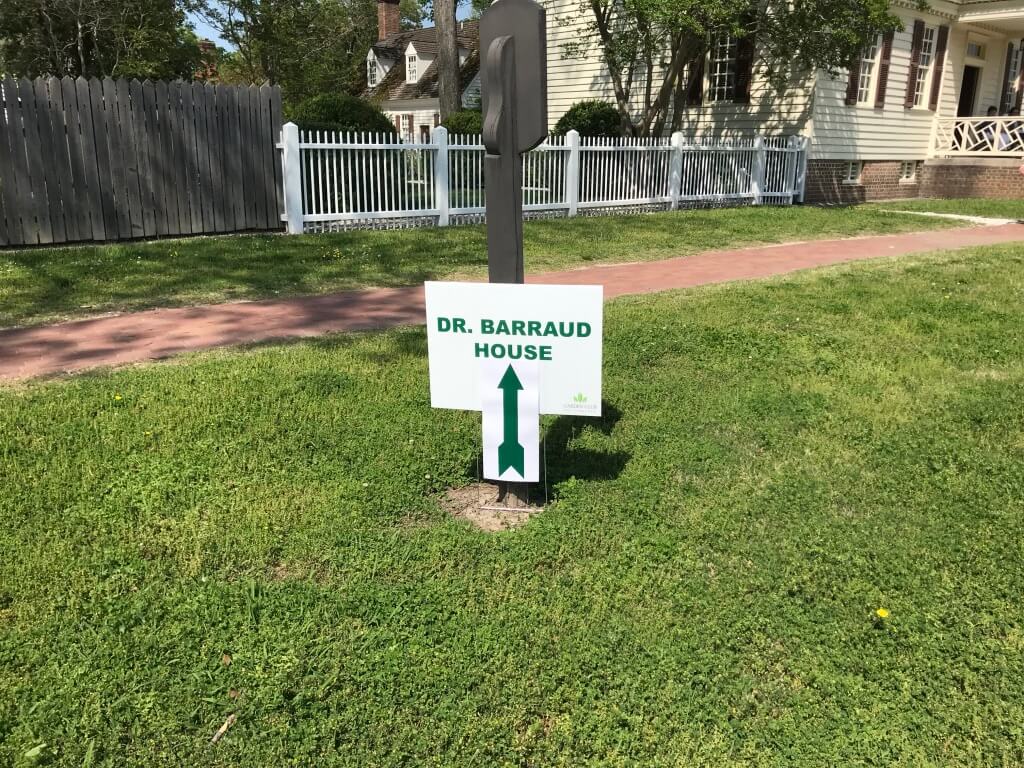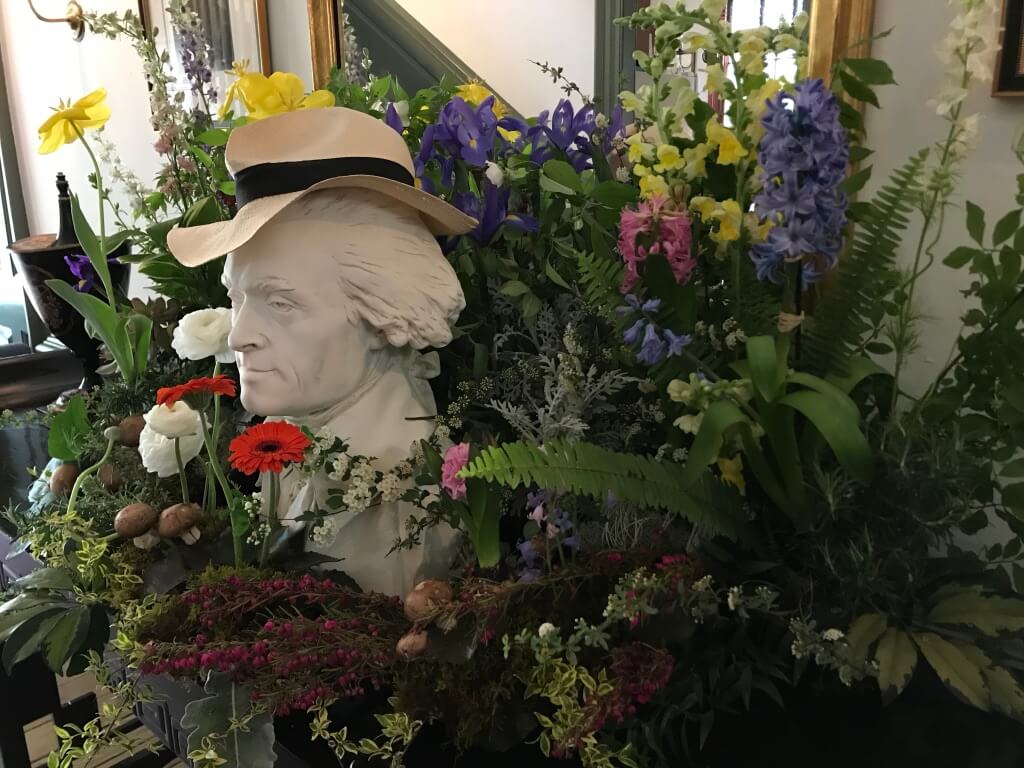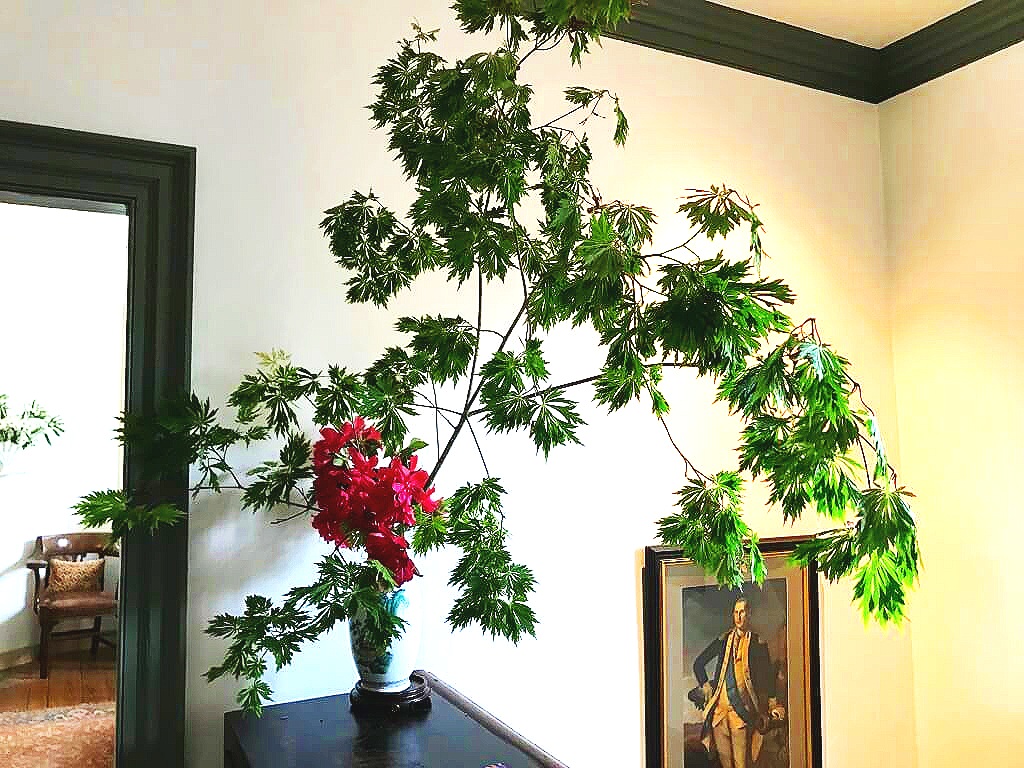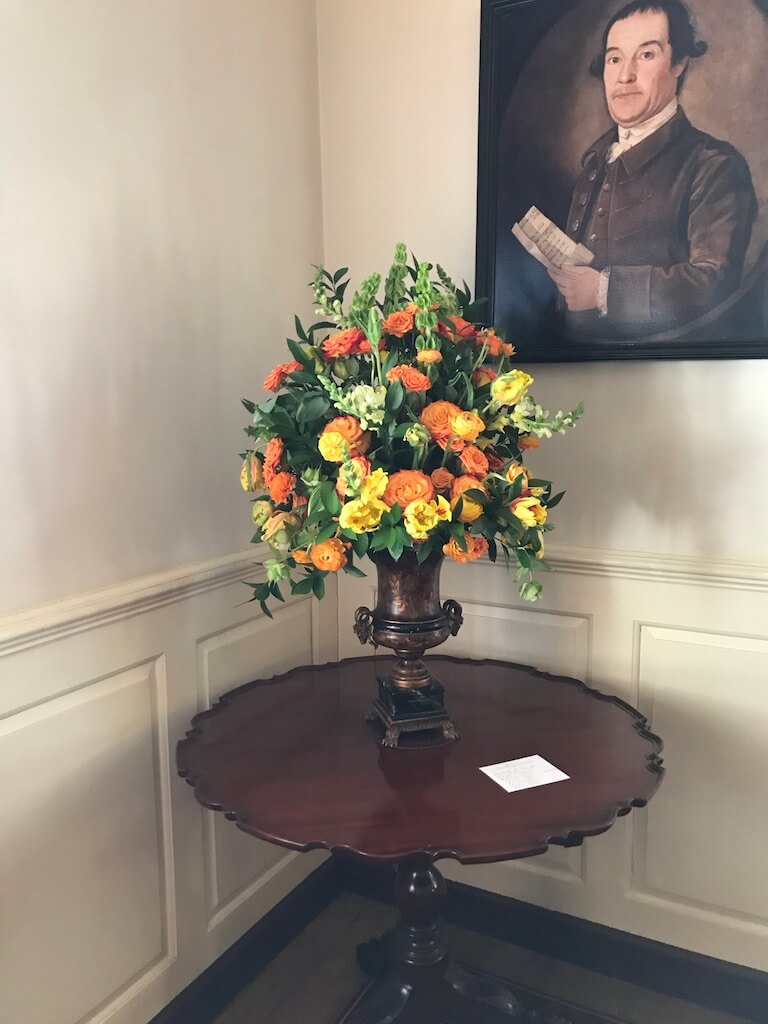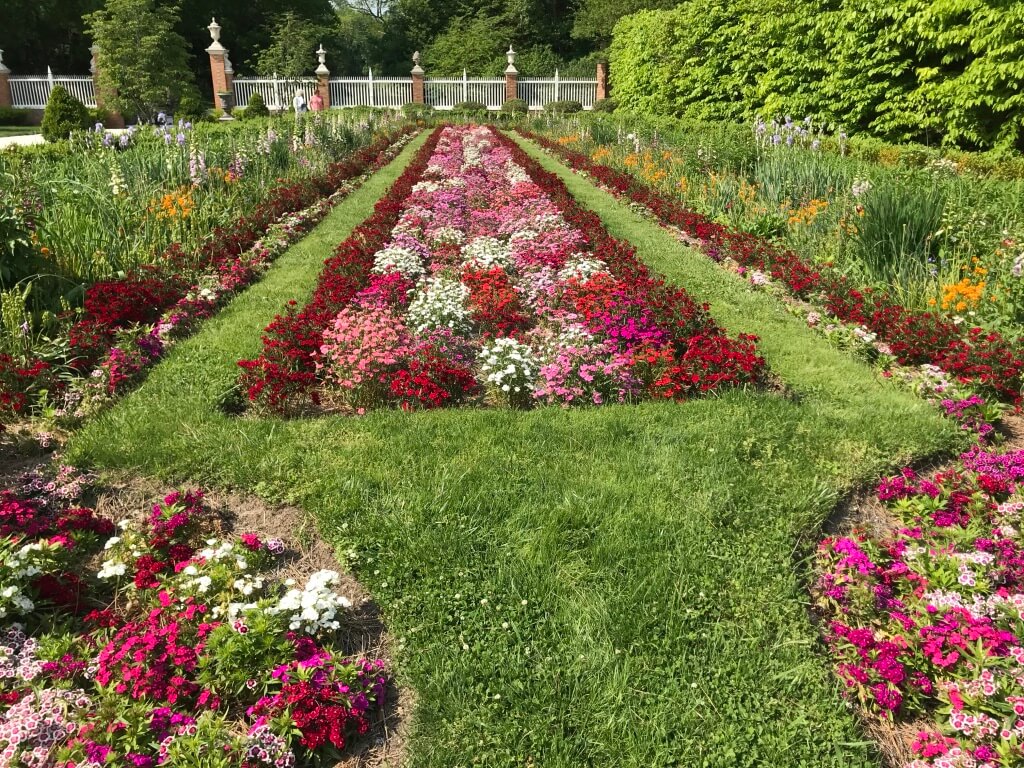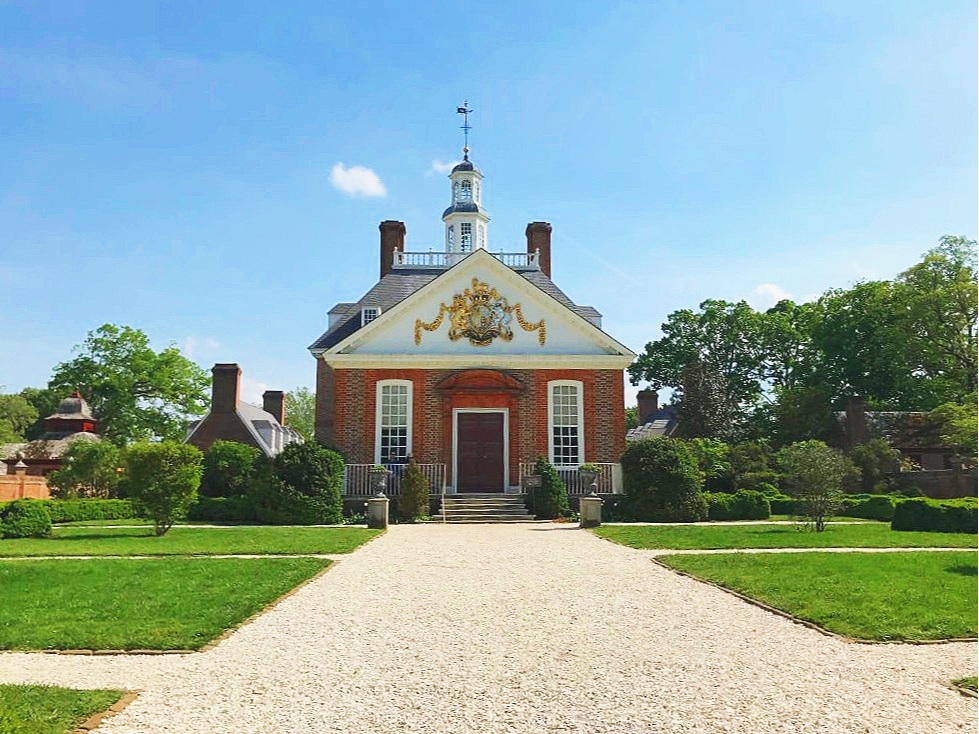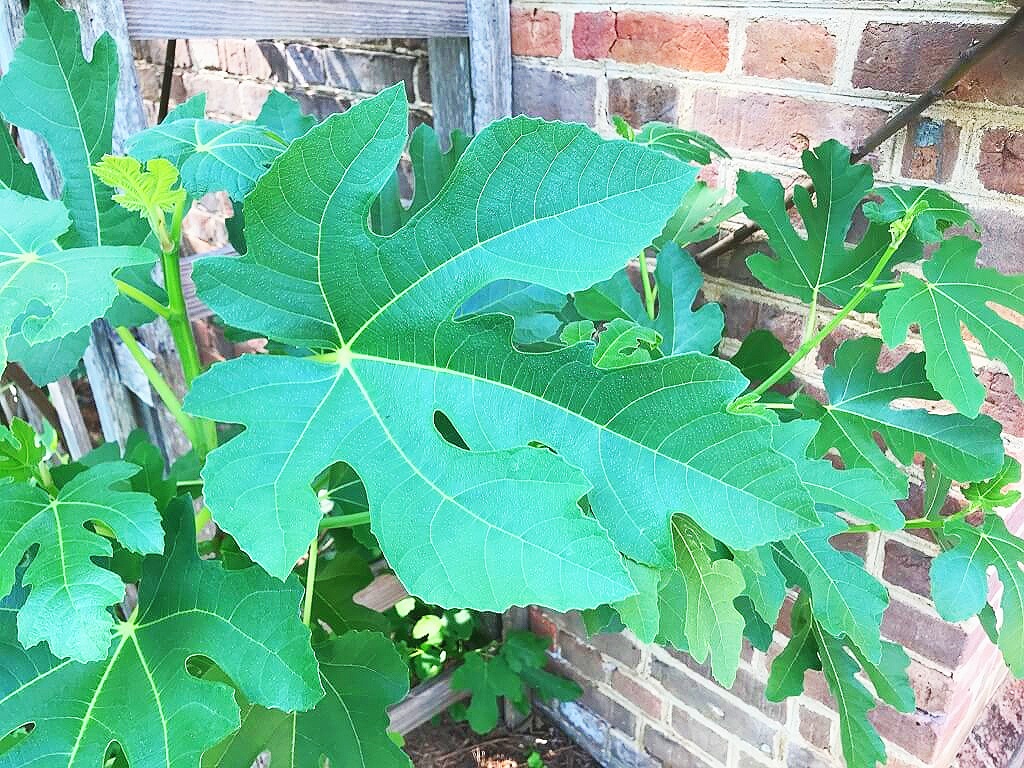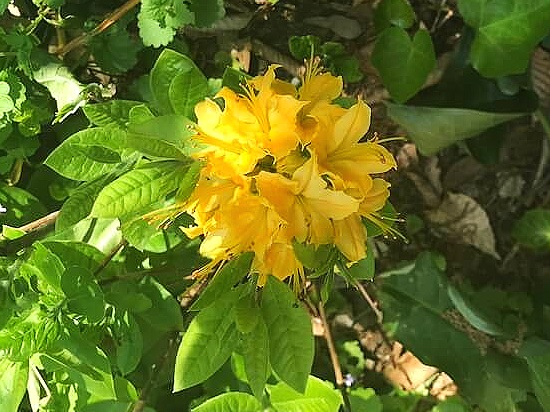Historic Garden Week in Virginia: Williamsburg
Affiliate Disclosure: This page may contain affiliate links, meaning that I receive commissions for purchases made through those links, at no cost to you.
Wonderful Williamsburg!
With a Quick Tip of the Hat to Jamestown…
(Because I Cannot Resist!)
I absolutely love Williamsburg—everything about it. And don’t get me started on Jamestown. I’m already digressing, but this will be quick. I have always been utterly fascinated by Jamestown—my sisters and I used to visit with our parents, and of course because we grew up just down the road, we enjoyed more than a few field trips to both Williamsburg and Jamestown during our school years. So I naturally lump the two together. Alas, there are no garden tours at Jamestown. And no flowers that I can think of. But if you’re interested in learning what’s been discovered in recent years—so much!!—and how these new discoveries have changed our understanding of the first permanent English settlement in America, head on over to Jamestown Rediscovery and check out the Dig Update Archive. There’s your PSA for the day. Now, we’ll return to our regularly scheduled postings…And this one is about the Williamsburg Garden Tour. So let’s go…
Grissell Hay House on W. Nicholson Street, Colonial Williamsburg, Illustration by Marcia Long.©betsygibsondesign
Side view of Grissell Hay House. LOOK at that Boxwood! Old growth, maybe???? And no blight! Beautiful!!©betsygibsondesign
Colonial Williamsburg
There were two Colonial Williamsburg (“CW”) houses on the Garden Tour this year, the Grisell Hay House (photos above) and the Dr. Philip Barraud House (photos below). In addition, the Gardens at the Governor’s Palace were open. I desperately wanted to visit the Gardens at the Palace because I hadn’t seen them in years (we’re talking DECADES…I know, a total travesty for someone as obsessed as I am with flowers and anything that grows from the ground up!). It was about 90 degrees, and by this point in the afternoon—4PM—my parents and I had all really had enough. We were hot, tired and thirsty. But I was determined to see the gardens. Stay tuned to find out what happened! Let’s put it this way…what happened could only happen to me.
Can you guess where I’m going….? ©betsygibsondesign
Not a very good shot of the Dr. Barraud house on E. Francis Street, but you get the idea! ©betsygibsondesign
GRISSELL HAY HOUSE
The Grissell Hay House, like so many other historic houses, did not originally belong to Grissell Hay. Nor was it the boarding house that Grissell Hay, the wife of a later owner of the property, turned it into. According to the earliest property records, which can be found in brief in the Colonial Williamsburg Digital Library , the house was originally called the Archibald Blair House because the land on which the house stands was the first parcel granted to Dr. Blair in 1716 by the City of Williamsburg. At the same time he received that first land grant, Dr. Blair was also granted several additional lots contiguous to the main lot, and it is likely that he complied with the stipulation in the grant(s) that at least one dwelling be built on each of the properties within 24 months of purchase, lest the property escheat back to the state. In other words, Dr. Blair received the land grant, but he couldn’t just sit on it. He had to build some sort of dwelling on each parcel in order to keep the land. So he got to work and built at least “one or more good dwellings” in accordance with the requirements set forth by an “Act of the Assembly of 1705”. Please do see the Colonial Williamsburg Foundation Library Research Report Series-1558 (H.D. Farish, 1940), my source for this information and the quotations, as it traces the ownership of the property and the house (and its various iterations) through about 1861-1862.
Perfection! Yellow Dogwood and Euonymus (Wintercreeper) by a Williamsburg Garden Club Member.
Fabulous Rose, Freesia and Greens arrangement by a Williamsburg Garden Club Member.
Beautiful arrangement of Lily, Ranunculus, Rose, Spray Rose, Freesia, Mums, Seeded Eucalyptus and Craspedia by a Williamsburg Garden Club Member.
The Grissell Hay House. A garden path through the old growth boxwood. Fortunately, this boxwood has not been hit with the blight that has been so pervasive throughout Virginia.©betsygibsondesign
As you can (and will below!) see from the photographs, the flowers done by the Williamsburg Garden Club (“WGC”) were absolutely exquisite and reflected so well the period and furnishings of the houses. While I do not have photos of the floral designs that were in the Ford’s Colony houses (as they are not CW houses but are privately owned), I can tell you that they, too, were absolutely beautiful. I am always impressed with the flowers that come out of the WGC. A truly talented bunch!!
Why, it’s Mr. Jefferson! We know how he loved his gardens. And he lived for a time at the Governor’s Palace, of course, so he fits right in here in Williamsburg. He also went to law school at William & Mary. He sure had some seriously nice digs throughout his lifetime, didn’t he? And he’s graced some seriously nice digs ever since! This design was created by Elgin Morris of Williamsburg Floral. ©betsygibsondesign
Incredible Full Moon Japanese Maple with Bright Pink Rhododendron in full bloom. A beautiful greeting for the second floor! ©betsygibsondesign
Beautiful springtime bedroom arrangement with perfect orange Ranunculus that make the entire design pop! ©betsygibsondesign
Detail of a design created with pitcher plants, or trumpet pitchers, which belong to the genus Sarracenia. This genus grows here in North America, and there are a couple of species that thrive right in our area. They are carniverous plants (!!) and generally attract insects, frogs and even mice. Can you believe it? And the gorgeous blooms that you see are part of the same plant. In addition, there are Mums, Succulents and Moss contained in this arrangement.
This was a work in progress when I saw it…it’s Fringe Tree. What a great filler for a a fireplace when not in use! ©betsygibsondesign
Perfect in its simplicity. But utterly chic at the same time. ©betsygibsondesign
DR. BARRAUD HOUSE
According to the hostess at the Barraud property, this house was probably built in the late 1700s, though not by Dr. Barraud. Dr. Barraud purchased the house after having served as a soldier in the Revolutionary War and having gone on to become a doctor. He was also, incidentally, a member of the Board of Visitors of the College of William and Mary (like my father, the Robert S. Roberson who seems to pop up in my posts every so often!!) Eventually, according to the Colonial Williamsburg website used to learn more about the Grissell Hay house, once Dr. Barraud became the Chief of Staff at the Norfolk Marine Hospital, he sold the house to Mrs. Anna Byrd, who, like Grissell Hay, turned the house into a boarding house. It was subsequently owned by several different families through the years, with the most recent owner having purchased the house in 1924. The most recent owner’s name was Mary Ryland, and she was quite astute in her estate planning, it seems. After almost 20 years in the house, she conveyed it to the Colonial Williamsburg Foundation but retained a life tenancy to the property, where she lived until her death in 1983. It’s amazing to think of the number of times in my life that I’ve passed that house—either on foot or in the car with my parents or grandparents—while an actual “owner” was living inside of it.
Stunning front entryway arrangement graciously provided by CW.
According to the website, the brickwork and framing are original to the house, and they show that the house was built—like many others of the era—in two different phases. During the first restoration of the house, it was discovered that the framing was a mixture of pine and poplar. And of great interest to me (and you’ll hear all about this when I begin my series on the restoration of my 1796-1801-1850 farmhouse located outside of Boston), the “principal framing members are hewn, riven and pit sawn and secured with mortise, tenoned and lap joints.” Sounds familiar!!
Lovely spring arrangement graciously provided by CW.
The Colonial Williamsburg website that I have cited so many times in this post goes further with the history of the Barraud house and its layout than it does with the histories of some of the other historic houses, possibly because the article presented with respect to this house was prepared by Carl Lounsbury, an architectural historian in the Department of Architectural and Archaeological Research, in 2004.
According to the research presented in Carl Lounsbury’s piece, it is known that the front door is still in its original location, as are the front windows of the house. The front hallway, or “central passage”, as it’s called in the CW website, did not exist originally. Instead, the front door opened into a large ground floor room. In addition, the stairs have been moved from their original position—thought he original positioning of the stairs is unknown. The most interesting part of the interior of this house is the fact that the “paint analysis suggests that most of the present 18th century interior doors and architraves, exterior windows architraves, floorboards and parts of the raised panel wainscoting date from the first period of construction” of the house. So it’s wonderful to have been able to conduct these various paint analyses while also trying to trace the structural evolution of the house and other buildings on the Barraud lots. Please check out the website for more details. There is a lot more than I thought there would be about the particulars of the Barraud House. There are also additional references in the Endnotes section that refer the reader to the Rockefeller Library and to the Library of Virginia. Small house, big history!
An arrangement in a soft palette complements the wallpaper in the Barraud dining room and was graciously provided by CW.
THE PALACE GARDENS
I’ve always thought of the Palace Gardens as a hidden treasure in Williamsburg. I still think of them that way, although I will now forever be wary of the world famous Palace Maze—I think I’ve had my last foray into it, in fact. Good thing I took photos! They tell the story of the Gardens and the Maze much more effectively than my words ever could. Enjoy!
Finally! Somewhere to cool down after having walked almost a mile to get to the Palace Gardens. I was determined! But not yet used to 90 degree heat….and did I mention that I was dehydrated? Not following my own Garden Tour advice to stay hydrated!!…oops. There is another arbor like this one directly across the Garden, defining the other “outer edge” of the Main Palace Garden. ©betsygibsondesign
One side of the Main Garden Green at the Palace Gardens. Each side of the Main Green, which is divided into two separate strips by a wide oyster shell path leading down to the end of the garden, mirrors the other in terms of layout and plant material. ©betsygibsondesign
These urns are fabulous and stand at the “top” of the Palace Garden. One on either side of the wide path. ©betsygibsondesign
Leading to a Side Garden. Palace Gardens. ©betsygibsondesign
Perfect Palace Garden Day! ©betsygibsondesign
The sun looked so beautiful shining down into the Palace Garden (outer garden). ©betsygibsondesign
Close to perfect. Palace Gardens. ©betsygibsondesign
Fruitery at the Palace Gardens. ©betsygibsondesign
The elusive Yellow Azalea! This was all alone in a perimeter bed on the outside of the main Palace Garden. And within 20 feet of it was one single Heirloom Daffodil. ©betsygibsondesign
An Heirloom Daffodil: The Poet’s Daffodil (Pheasant’s Eye, too) was one of the first daffodils to be cultivated. And he was just a few steps away from the yellow Azalea in the photo above. ©betsygibsondesign
AND FINALLY, THE MAZE…
I GOT LOST. YES. I DID. THREE TIMES.
I used to love the Boxwood Maze at the bottom of the Palace Garden. Not anymore! Not after yesterday. But that’s only because I got lost THREE times in it yesterday afternoon! THREE TIMES! (Yes, I do have video evidence of my several unsuccessful attempts to get to the other side of the maze, but were I to post it, I would ruin my image. Whatever said image may be!! Or I don’t know. Maybe I could enhance the ol’ image. I’ll think about it…
In any event, after some time locked in the Morass of the Maze (as I was calling it by the time I made my way out of it), I did find my way back to the entrance of the Maze. But I can be heard on one of my videos before finding that gorgeous, gorgeous bit of black fencing that led me back out to the wide open world again (well, the black metal fence is not actually gorgeous…but it is necessary these days) saying, “I wonder if they check this thing before closing for the night…to make sure there’s no one left in here”!!!) Let’s just say that it was 90 degrees outside, we had been on the Garden Tour all day, I was still wearing my Charleston Shoe Co espadrilles (which are great on the cobblestones of Nantucket and anywhere else, but NOT so great over roots or ruts in the ground) and my mother was texting me asking where in the world I was…she and my father were waiting for me at the Inn. They were enjoying a leisurely drink while I was insistent upon going through the Gardens and the Maze. I should have gone to the Inn and left my fond memories of the Maze in tact. I texted back (in what AG Barr would certainly have called a “snitty” text) that I was drenched in sweat, lost in the maze for the third time and was also grappling with a spider web that had somehow adhered itself to the side of my face. My mother must have thought I was beyond all hope. I did eventually make it to the Inn, however. After about an hour…I guess I should have left breadcrumbs! When I showed my mother the videos of my escapade on the ride back to the house, she could not contain her laughter. I must admit, they are beyond funny. But you’d have to know me to truly appreciate them! So I’ll spare you the videos and leave you with some photos of the Maze that have been taken by others through the years. From the safety of OUTSIDE the confines of the Maze! It is a beautiful place like no other.
May 15, 1935. The Maze and Palace Gardens.© Nivison, Frank, “Governor's Palace Gardens,” John D. Rockefeller Jr. Library, Colonial Williamsburg Foundation, https://rocklib.omeka.net/items/show/1890.
A View of the Maze.©Colonial Williamsburg Foundation 2010.
My view from “Inside the Maze”. Note the “new” black steel (??) fencing. When I was a little girl, I remember the maze as being REALLY high, and I don’t remember any sort of man made barriers. Time changes things. But I was still lost when I took this photo (part of a video, actually!) ©betsygibsondesign
FORD’S COLONY
For the first time, Ford’s Colony was part of the Williamsburg Garden Tour this year. Although Ford’s Colony is located outside of the Historic District, it’s not far, and the Tour could not have had a better flow. Whether you started downtown in the Historic District or at Ford’s Colony (as we did), the WGC made the entire tour lovely, easy and fun. There were shuttle buses that ran consistently throughout the day—we never had to wait more than 2 minutes for a bus—and there was a beautiful luncheon at the Ford’s Colony Country Club with seatings at 11:30 or 12:30. The two seatings made it very easy to accommodate everyone who had purchased a ticket for the luncheon, and the seating times were early enough in the day to allow for whatever schedule any ticket holder could desire. In other words, there was zero stress associated with trying to plan the day. *Unless, of course, you are me and decide to go to the Palace Gardens and proceed to get lost and stuck in the maze for longer than you’d care to admit. But that is my fault entirely!!
The Ford’s Colony houses, like the Colonial Williamsburg properties, were filled with incredible arrangements that complemented the decor and captured the spirit of each and every house. It was a delight to see so many beautiful flowers and so many eager crowds! Congratulations to the WGC on a fantastic tour!!



